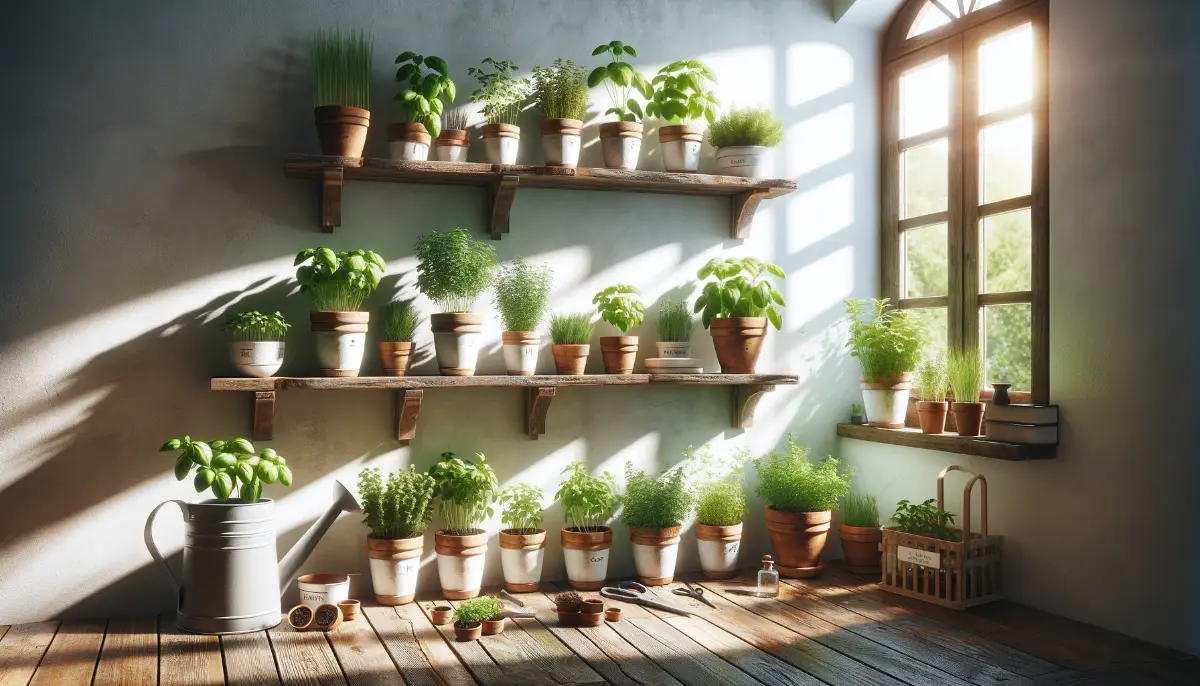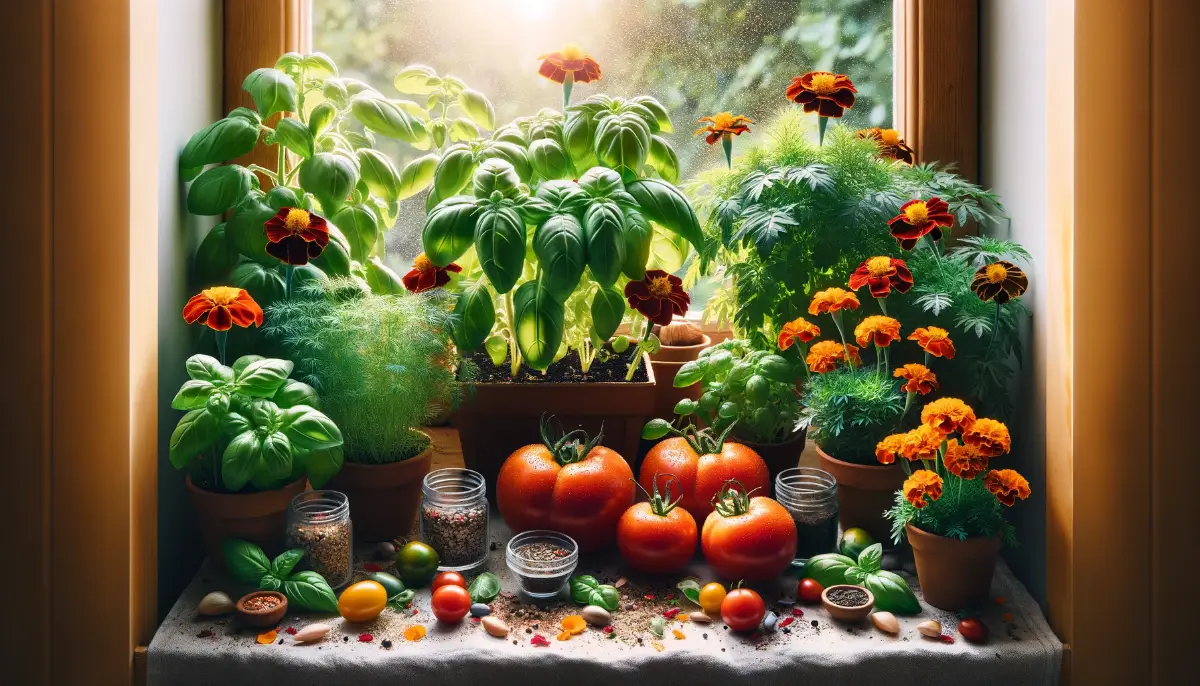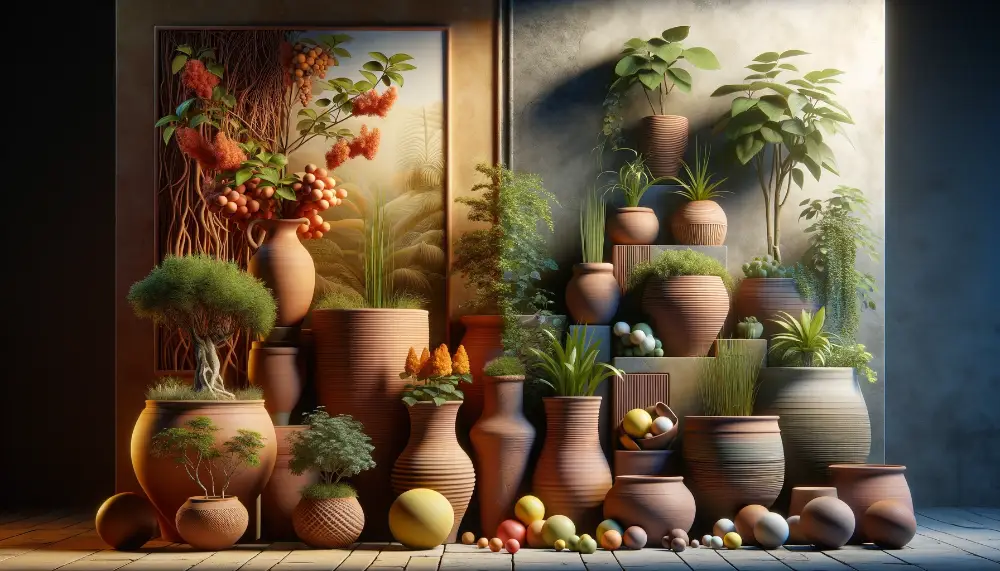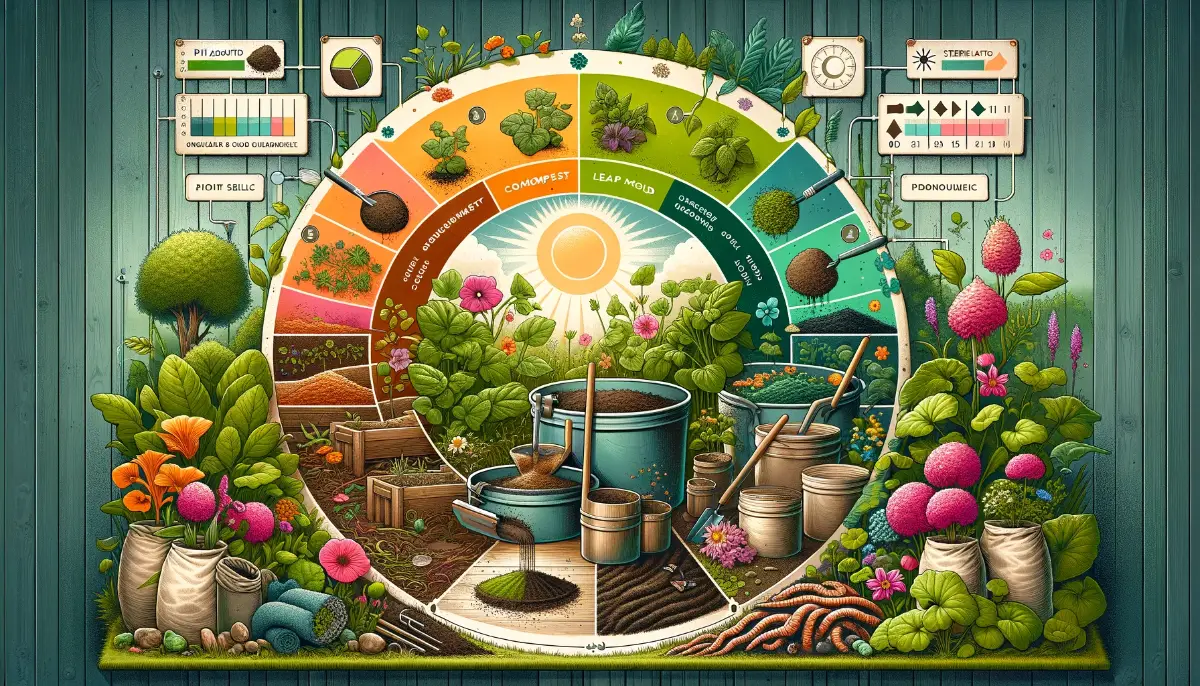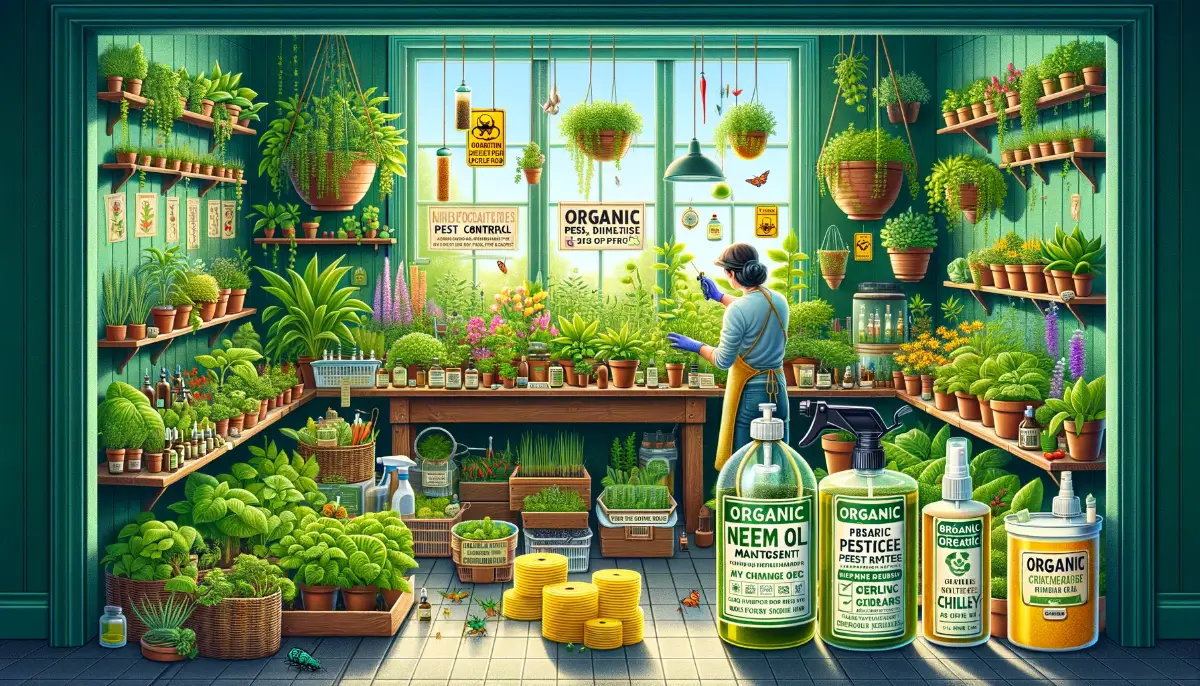Creating a simple indoor herb garden is not only a way to add a bit of greenery to your living space but also a practical approach to have fresh herbs at your fingertips.
Whether you’re a seasoned gardener or a novice, this guide will walk you through setting up your very own indoor herb garden, tailored to thrive in a home environment.
- Select herbs that thrive indoors such as basil, oregano, and mint.
- Use the right container and soil type to ensure healthy growth.
- Place your garden in a location with adequate light or supplement with grow lights.
- Regular watering and humidity control are crucial for herb vitality.
- Harvest your herbs correctly to encourage continuous growth.
Starting an indoor herb garden brings the joy of gardening inside, offering fresh flavors right from your windowsill. It’s a simple pleasure and a sustainable choice for culinary enthusiasts or anyone looking to green their living space.
Selecting Your Herbs
Selecting the right herbs is the cornerstone of creating a successful indoor herb garden. This choice will shape your gardening experience and influence the flavors available at your fingertips. Let’s delve into how to pick the perfect herbs for your indoor sanctuary:
Culinary Preferences
Start by considering your cooking habits. Are there specific herbs you find yourself reaching for again and again? Whether you’re crafting Italian cuisine that calls for basil and oregano, or preparing aromatic teas that require mint and chamomile, your culinary preferences should guide your selection.
Space Considerations
Evaluate the space you have available. Some herbs, like mint, are known for their vigorous growth and can easily take over if not contained. Compact herbs such as chives and thyme are ideal for smaller spaces or window sills.
Growth Conditions
Most herbs thrive in similar conditions—ample sunlight, well-draining soil, and regular watering. However, it’s worth noting that some herbs, like basil, are more sensitive to cold drafts, whereas others, such as rosemary, prefer drier conditions. Tailoring your selection to match your indoor environment will set you up for success.
Easy-to-Grow Herbs for Beginners
If you’re new to gardening, some herbs are easy to grow, making them excellent choices for beginners:
- Basil: A must-have for any kitchen, basil is easy to grow from seed and loves lots of light.
- Mint: Known for its vigorous growth, mint is best grown in its own container to prevent it from overtaking other plants.
- Parsley: Both curly and flat-leaf varieties are simple to cultivate and don’t require as much sunlight as other herbs.
- Chives: Hardy and drought-resistant, chives can do well with less attention than other herbs.
Cilantro: Fast-growing and with a distinctive flavor, cilantro can be grown from seeds and enjoys cooler indoor temperatures.
Choosing the Right Containers for Herbs Garden
When it comes to setting up an indoor herb garden, selecting the right containers is just as crucial as choosing the herbs themselves. The right container can significantly affect your herbs’ health, growth, and productivity. Here’s a detailed look at how to pick the perfect pots for your green companions:
Consider Drainage
- Drainage Holes: Essential for preventing water from pooling at the bottom, which can lead to root rot. Ensure your containers have adequate drainage holes.
- Trays and Saucers: Use them beneath pots to catch excess water and protect your surfaces.
Material Matters
- Terracotta and Clay: Porous materials that allow air and water to move through, which can help prevent overwatering but may require more frequent watering due to faster soil drying.
- Plastic and Resin: Lightweight and retain moisture longer, making them a good choice for herbs that prefer consistent moisture. However, ensure they have good drainage.
- Metal and Glass: Less common and can look stylish, but be cautious as they can affect soil temperature and may not offer good breathability.
Size and Space
- Root Room: Select a size that provides ample room for the herb’s roots to grow. A general rule is to choose containers that are at least 6-8 inches deep for most herbs.
- Growing Space: If planning to grow multiple herbs in one container, ensure there’s enough space for each plant to spread out without overcrowding, promoting better air circulation and growth.
Self-Watering Planters
- For those who travel frequently or tend to forget watering, self-watering planters can be a lifesaver. They have a reservoir at the bottom that allows plants to take up water as needed, reducing the risk of under or overwatering.
Aesthetic and Practical Considerations
- While the health of your herbs is paramount, choosing containers that match your home decor can also bring added joy. Consider the style, color, and texture of pots that will complement your space.
- Mobility: If you need to move your herbs to catch the sun or protect them from drafts, consider lightweight materials or containers with wheels.
Upcycling Options
- Don’t overlook the possibility of repurposing items you already have at home. Old mugs, jars, and even tin cans can be transformed into unique herb containers. Just make sure to add drainage holes.
By taking the time to choose the right containers for your indoor herb garden, you ensure that your herbs have the best possible environment to thrive, leading to a lush, fragrant, and productive garden right in your home.
Soil and Planting
The foundation of any healthy indoor herb garden lies in choosing the right soil and understanding the basics of planting. This section will guide you through preparing your containers with the best soil mixture and planting your herbs to ensure a thriving indoor garden.
Choosing the Right Soil
- Potting Mix: Opt for a high-quality potting mix designed for indoor plants. These mixes are sterile, preventing disease, and are formulated to hold moisture without becoming waterlogged.
- Aeration and Drainage: The soil should be loose and well-draining to allow roots to breathe and grow freely. Mixing in perlite or vermiculite can improve aeration and drainage.
- Nutrient Content: Consider a potting mix that includes a slow-release organic fertilizer. Herbs don’t require very nutrient-rich soil, but a little compost can enrich the soil without the need for frequent fertilization.
Preparing Your Containers
- Drainage: Ensure your containers have adequate drainage holes. If they don’t, drill some or add a layer of gravel or broken pottery at the bottom to facilitate drainage.
- Filling Containers: Leave about an inch of space from the top to prevent soil from spilling out when watering.
Planting Your Herbs
- From Seed: Plant seeds according to the packet’s instructions, usually at a depth of two to three times the diameter of the seed. Keep the soil moist until germination.
- Starter Plants: Gently remove the plant from its nursery pot, loosen the roots, and plant it at the same depth it was in the pot. Press the soil gently around the roots to eliminate air pockets.
Watering After Planting
- After planting, water your herbs thoroughly to settle the soil around the roots. Use lukewarm water to avoid shocking the plants.
Light and Location
- Immediately place your planted herbs in a location where they will receive adequate sunlight, as per each herb’s specific needs, typically a south-facing window that offers six to eight hours of sunlight.
Monitoring and Maintenance
- Germination: If starting from seeds, keep the soil consistently moist but not waterlogged. Covering the pots with plastic wrap can help retain moisture until seeds germinate.
- Growth: Once herbs are established, adjust watering according to the plant’s needs, allowing the soil to dry slightly between watering.
Final Touches
- Labeling: It’s helpful to label your herbs, especially when starting from seeds, to keep track of their growth and care requirements.
- Thinning Seedlings: If you planted multiple seeds per pot, thin the seedlings to prevent overcrowding, leaving the strongest plant.
Harvesting
Harvesting encourages growth, but it’s important to do so correctly. Cut leaves or stems above a node to promote new growth, and never harvest more than a third of the plant at one time to keep it healthy.
To maintain a healthy indoor organic herb garden, it’s crucial to avoid common pitfalls such as lack of drainage, using the wrong soil type, overwatering, underwatering, and neglecting pruning and harvest.
Use containers with drainage holes, opt for well-drained potting soil, water only when the soil is dry to avoid overwatering, check the soil moisture regularly to prevent underwatering, and regularly prune and harvest your herbs to encourage growth. These steps will help ensure your indoor herb garden thrives, providing fresh herbs for your culinary needs.
Pest Management and Disease Prevention
Pest management and disease prevention are critical aspects of maintaining a healthy indoor herb garden. Understanding how to tackle these challenges can help ensure your herbs thrive, providing fresh flavors for your kitchen year-round. Here’s a guide on managing pests and preventing diseases in your indoor herb garden:
Preventive Measures
- Proper Spacing: Ensure your herbs have enough space between them to promote air circulation, reducing the risk of fungal diseases.
- Cleanliness: Keep the area around your plants clean and free of debris. Regularly inspect new plants for pests before introducing them to your garden.
- Quarantine: Isolate new or affected plants to prevent the spread of pests and diseases to healthy plants.
Pest Identification and Control
Identify pests early to manage them effectively. Here are common pests found in indoor gardens and ways to control them:
- Aphids: Small, soft-bodied insects that can be green, black, brown, or red. Control them by wiping with a damp cloth or spraying with a mix of water and a few drops of dish soap.
- Spider Mites: Tiny spider-like pests that cause yellow speckling on leaves. Increase humidity around your plants and use a neem oil spray to combat them.
- Fungus Gnats: Small black flies around the soil surface. They thrive in wet soil. Allow the soil to dry out between waterings, and use sticky traps to catch adults.
- Whiteflies: Small, white flying insects. They can be controlled with yellow sticky traps and by spraying the undersides of leaves with insecticidal soap.
Disease Management
- Fungal Diseases: Common in damp conditions. Ensure good air circulation, avoid overhead watering, and allow the soil to dry slightly between waterings.
- Root Rot: Often caused by overwatering. Use well-draining soil and pots with drainage holes. If root rot is detected, you may need to repot the plant into fresh soil, trimming away any rotten roots.
Natural and Organic Solutions
- Neem Oil: An organic oil that acts as a pest repellent and fungicide. It’s safe for herbs intended for culinary use.
- Insecticidal Soap: Effective against many pests and safe for use on edible plants. Apply according to label instructions, typically in the evening or when the plant is not in direct sunlight.
- Diatomaceous Earth: A non-toxic powder that can be sprinkled on the soil surface to kill pests. It’s effective against crawling pests like ants and slugs.
Monitoring
- Regularly check your herbs for signs of pests or disease. Early detection is key to successful management.
- Monitor the health of your plants, including leaf color and growth patterns, to catch potential issues early.
Implementing these strategies for pest management and disease prevention will help keep your indoor herb garden healthy and productive. Remember, the best defense is a good offense: taking preventive measures can significantly reduce the likelihood of pest and disease problems.
FAQs about Indoor Herb Gardening
What are the best herbs to grow indoors?
Start with herbs that thrive in indoor conditions like basil, mint, cilantro, parsley, and chives, due to their light and watering needs aligning well with indoor environments.
How much light do indoor herbs need?
Most herbs require about 6-8 hours of sunlight per day. South-facing windows are ideal, but if natural light is limited, grow lights can supplement.
How often should I water my indoor herbs?
Water when the top inch of soil feels dry. Overwatering is a common mistake; ensure pots have drainage holes to help avoid this.
Do indoor herbs need special soil?
Use a high-quality potting mix that ensures good drainage. Avoid using garden soil, as it can compact and hinder root growth.
Can I use fertilizers for my indoor herb garden?
Yes, but sparingly. Opt for organic fertilizers designed for edible plants, and follow the instructions for dilution and frequency.
Why are my herb leaves turning yellow?
Yellowing leaves can be a sign of overwatering, under-watering, or a nutrient deficiency. Assess your watering routine and consider a mild fertilizer.
How can I prevent pests in my indoor herb garden?
Keep the area clean, ensure proper spacing between plants, and inspect new plants before introducing them to your garden. Use neem oil or insecticidal soap for outbreaks.
What is the best temperature for growing herbs indoors?
Most herbs prefer temperatures between 65-70°F (18-21°C) during the day and slightly cooler at night.
Can I grow herbs indoors year-round?
Yes, with adequate light and care, most herbs can be grown indoors throughout the year.
How do I harvest herbs without harming the plant?
Always snip or pinch off leaves from the top to encourage bushier growth, and never remove more than one-third of the plant at a time.

